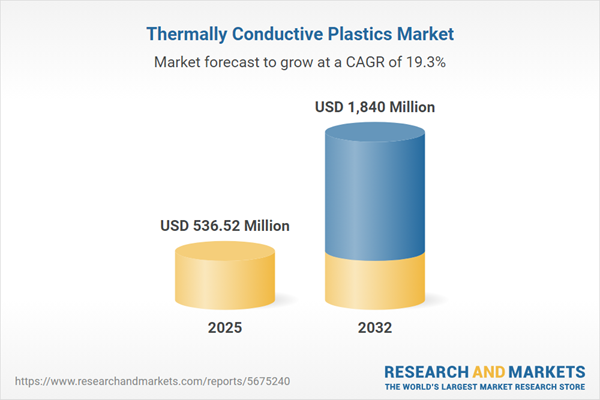Speak directly to the analyst to clarify any post sales queries you may have.
Thermally conductive plastics are redefining thermal management strategies for advanced industries, offering a unique combination of design flexibility, efficient heat dissipation, and optimized manufacturing. As lightweight alternatives to metals and ceramics, these polymer solutions are unlocking new opportunities for innovation across diverse sectors.
Market Snapshot: Thermally Conductive Plastics Market Size and Growth
The thermally conductive plastics market reached USD 449.61 million in 2024 and is projected to grow to USD 536.52 million in 2025, sustaining a CAGR of 19.28%. By 2032, the market is forecast to attain USD 1.84 billion, reflecting broad adoption in sectors such as automotive electrification, electronics, and industrial equipment.
Scope & Segmentation
This market report provides an in-depth analysis of the following:
- Material Types: Epoxy, polyamide, polyester, polypropylene, silicone.
- Filler Types: Carbon (carbon black, carbon nanotubes, graphite), ceramic (alumina, boron nitride, silicon carbide), metal (aluminum, copper, silver).
- End Use Industries: Aerospace (interiors, structural components), automotive (battery components, electrical systems, engine components), consumer goods (appliances, sports equipment, wearables), electronics (LED lighting, PCB, power electronics, semiconductors), industrial (HVAC, machinery, power generation).
- Applications: Heat sinks (fin, pin fin, plate fin), heat spreaders (flexible, rigid), thermal insulation (foils, sheets), thermal interface materials (gap fillers, greases, TIM pads).
- Form Factors: Films (thick, thin), pellets, powders (micro, nano), rods (round, square), sheets (standard, ultrathin).
- Regions Covered: Americas, Europe, Middle East & Africa, Asia Pacific—with dedicated analysis of key countries including the United States, China, Germany, Japan, and others.
- Technology Adoption: Integration of advanced fillers, additive manufacturing, bio-based resins, and closed-loop recycling schemes, alongside next-generation injection molding and 3D printing processes.
- Key Players: Leading companies such as DuPont de Nemours, Inc., Saudi Basic Industries Corporation, Celanese Corporation, BASF SE, Avient Corporation, EMS-CHEMIE AG, RTP Company, Kaneka Corporation, Mitsubishi Chemical Holdings Corporation, and Laird Performance Materials, Inc.
Key Takeaways for Decision-Makers
- Material innovation, particularly with engineered fillers and tailored polymer matrices, is enabling unprecedented thermal performance and durability.
- Collaboration between resin compounders, OEMs, and filler specialists accelerates product development and supports differentiated solutions for industry-specific requirements.
- Manufacturing advancements—like additive techniques and optimized compounding—are providing new levels of design flexibility and reducing time-to-market for complex components.
- Regional supply chain developments, including nearshoring in the Americas and expanded research capacity in Asia-Pacific, are driving both localized production and global partnerships.
- Sustainability initiatives are fostering the use of recyclable materials and eco-friendly fillers, aligning product offerings with evolving regulatory standards and market expectations.
- Segment-specific applications highlight the need for custom solutions, addressing thermal challenges in thermal interface materials, lightweight heat sinks, and robust insulation systems.
Tariff Impact: Adapting Supply Chains and Sourcing Strategies
Tariffs implemented by the United States in 2025 have led to a notable restructuring of global supply chains. Asian suppliers have shifted production strategies, strengthening partnerships within the Americas. Domestic capacity enhancements and revised sourcing models have proven critical, enabling companies to manage volatility, reduce dependency on imports, and maintain material availability across varied end-use sectors.
Methodology & Data Sources
This report applies a dual-layered research approach. Primary research includes direct interviews with C-level executives, R&D leads, and supply chain experts. Secondary research synthesizes data from technical white papers, industry publications, patent filings, and public disclosures. Integrative analysis leverages value chain mapping, segmentation modeling, and scenario planning, supported by sensitivity analysis and peer validation workshops.
Why This Report Matters
- Provides actionable insights to inform critical investment, sourcing, and product development decisions for senior executives.
- Clarifies evolving regulatory and sustainability landscapes, preparing businesses to capitalize on market shifts and compliance needs.
Conclusion
Thermally conductive plastics are emerging as essential enablers of next-generation thermal management, fostering innovation in compact, efficient systems. Stakeholders who embrace collaboration, agility, and environmental priorities will be best positioned to navigate this dynamic market landscape.
Additional Product Information:
- Purchase of this report includes 1 year online access with quarterly updates.
- This report can be updated on request. Please contact our Customer Experience team using the Ask a Question widget on our website.
Table of Contents
3. Executive Summary
4. Market Overview
7. Cumulative Impact of Artificial Intelligence 2025
List of Figures
Samples

LOADING...
Companies Mentioned
The key companies profiled in this Thermally Conductive Plastics market report include:- DuPont de Nemours, Inc.
- Saudi Basic Industries Corporation
- Celanese Corporation
- BASF SE
- Avient Corporation
- EMS-CHEMIE AG
- RTP Company
- Kaneka Corporation
- Mitsubishi Chemical Holdings Corporation
- Laird Performance Materials, Inc.
Table Information
| Report Attribute | Details |
|---|---|
| No. of Pages | 196 |
| Published | October 2025 |
| Forecast Period | 2025 - 2032 |
| Estimated Market Value ( USD | $ 536.52 Million |
| Forecasted Market Value ( USD | $ 1840 Million |
| Compound Annual Growth Rate | 19.2% |
| Regions Covered | Global |
| No. of Companies Mentioned | 11 |









